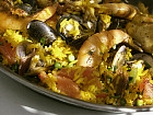|
Spanish Entree Saffron Rice & Seafood Paella (pah-ay-yah) is a glorious concoction of saffron rice with a variety of seafood and meat. 2 doz. mussels in shell* (see sidebar) Shellfish: using fresh water, soak mussels and clams (in separate bowls) for 30 minutes, allowing them to filter out sand. Remove mussels first from water (do not drain water because the sand is sitting in the bottom of the bowl). Pull off the beards, yanking toward the hinge end of the shell. Remove clams and rinse them, along with the mussels, under cold running water. Use a small brush to scrub all the shells clean. Peel and de-vein shrimp. Set aside. Chicken and Rice: pre-heat oven to 325. Heat oil in large deep skillet and cook chicken till golden brown on all sides. Remove and set aside. Add onions, garlic, and rice stirring till onions are soft and rice begins to turn golden. Soak saffron in 1 T hot water for 5 minutes. Add stock, salt, pepper, and soaked saffron, cover and simmer 10 minutes to let water absorb some liquid. Sausage: cook the chorizo in a separate skillet for 5 minutes. Drain all but 2 tsp. of the drippings and set aside. Assembly: Carefully stir in mussels, clams, shrimp, peas and tomatoes. Add chicken pieces to the top, cover, and place in oven for 30 minutes.** After 30 minutes, add chorizo (and 2 tsp. of the drippings) to paella. Return to the oven—leaving the lid off—and continue baking 10 more minutes. Serve in the skillet or turn into a large, shallow bowl. * Feel free to substitute a heavy white fish (cod, halibut) for whatever shell fish is unavailable. ** Keep a small pan of boiling water or stock on the back of the stove. Check on paella from time to time and add boiling stock or water if it looks dry. Make sure liquid is boiling, or it will slow the cooking process and make the rice gummy. |
Tips & Glossary Tapas are a cultural phenonemon in Spain (and now the world). Spaniards eat dinner quite late, so these small plates of food, served in local bars and taverns, fill the gap between lunch and dinner. Families and friends circulate between tapas bars to socialize and taste these delicious treats. When entertaining Spanish-style, do as the Spaniards do—load up your table with small plates of savory tapas. We’ve included plenty of recipes to help you out. Chili Peppers: any small, hot pepper (as opposed to larger, milder bell peppers). Spain’s habanero is the hottest pepper known, while the piquillo (pee-kee-yo) is intensely sweet. Serranos, originally from Mexico, are also used in Spanish cooking. Crabmeat: sweet, nutty-flavored meat from the body, legs or claws of numerous varieties of crab. Most prized is jumbo lump from the hind leg. For crab dips and fillings, use regular lump, or finback from the body. Buy it fresh if you can. Empanadillas: (em-pan-a- dee-yas), any raw or cooked filling wrapped in a dough and baked in the oven or over an open fire; a culinary treat that dates back to at least medieval times. Mussels: buy only mussels that are tightly closed, never open, chipped or broken. When you get them home, unwrap them so they can breathe and keep them cool before you use them. You don’t want them to die before cooking. Pinchos: (Pinxtos) Basque-style tapas, served on bread slices, with a toothpick (or "spike"–pinchos in Spanish) to hold the topping in place. Queso: cheese! Manchego is Spain’s most famous cheese, a semi-soft sheep’s milk cheese from La Mancha region. Delicious served as tapas: thinly sliced and topped with a slice of quince paste, like cranberry jelly. Roasted peppers: buy or make your own: place peppers under a broiler, or hold over a gas flame, till skin chars and blisters. Place in a closed paper bag for 15-20 minutes (to steam them). When cool enough to handle, the skins will slip off under running water. Saffron: the most expensive spice in the world, from the crocus plant cultivated in Iran and Spain. Along with its unusual taste, it adds a deep rich yellow color to food. Use a strand or two at a time and soak in warm water before using. Serrano ham: “mountain” ham; dry-cured Spanish ham, served raw in paper-thin slices. It’s similar to Italian Prosciutto.
|
Site by BOOM
![]()
LitLovers © 2024

